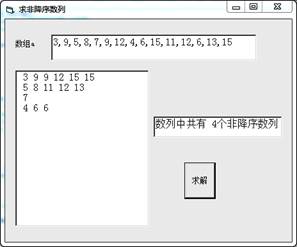⑴用数组依次存储每个非降序数列中最大的元素(查找过程中的最大值),初始时b(1)为数组a第1个元素。
⑵加入方法:将a(i)与数组b中的每个元素依次逐个比较:
若a(i)不比b(j)小就用a(i)替换b(j)中的值;将a(i)添加到第j个非降序数列中,并连接到c数组的c(j)中。
若a(i)比b(j)都小,则在数组b最后添加新的元素值为a(i),即将a(i)添加到第j+1个下降数列中,并连接到c数组的c(j+1)中。
⑶若数组a各元素的值为:12,36,16,36,27,18时,则3个非降序数列分别为:“12,36,36”,“16,27”,“18”。
程序运行界面如下图所示:

小明依据上述描述设计了如下VB程序。请回答下列问题:
Const m=15
Dim a(1 To m) As Integer Private Sub Form_Load()
‘读取m个数据,依次存储到 a(1)、a(2)、……a(m)中,代码略End Sub
Private Sub Command1_Click()
Dim b(1 To m) As Integer '存储数列最大的值Dim c(1 To m) As String ‘存储非降序数列Dim i As Integer
Dim bottom As Integer Dim j As Integer
Dim bn As Integer ‘存储非降序数列的个数List1.clear
b(1) = a(1)
①
c(1) = Str(a(1))
For i = 2 To m
For j = 1 To bn
If ② Then
b(j) = a(i)
![]()
Exit For
End If
Next j
If j > bn Then
bn = bn + 1
③
c(b(n)) = Str(a(i))
End If
Next i
For i = 1 To bn
List1.AddItem c(i)
Next i
Text2.Text = "数列中共有" + Str(bn) + "个非降序序列"
End Sub
① ② ③